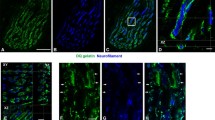Summary
Extensor digitorum longus muscles of male adult White New Zealand rabbits were indirectly stimulated at 10 Hz for 12 h daily for periods ranging up to 28 days. After four weeks the stimulated muscles showed a nearly uniform profile of high succinate dehydrogenase activity and, when incubated after acid preincubation for myofibrillar adenosine triphosphatase, displayed more dark- and intermediate-staining fibers than their contralateral counterparts. Muscles stimulated from between 6 to 21 days revealed degenerative foci and phagocytosis of degenerated fibers. These fibers were mostly of the fast-twitch, glycolytic type. Small myofibers, which often contained central nuclei, and structures identified as myoblasts or myotubes, reacted with a monoclonal antibody prepared against embryonic myosin heavy chains. The data suggest that under the employed conditions the fast to slow conversion of chronically stimulated fast-twitch rabbit muscle is not exclusively caused by adult fiber transformation, but results in part from the substitution of fast-twitch glycolytic fibers with newly formed fibers that have a high oxidative profile.
Similar content being viewed by others
References
Brooke MH, Kaiser KK (1970) Muscle fiber types: How many and what kind? Arch Neurol 23:369–379
Brown WE, Salmons S, Whalen RG (1983) The sequential replacement of myosin subunit isoforms during muscle type transformation induced by long term electrical stimulation. J Biol Chem 258:14686–14692
Buchegger A, Nemeth PM, Pette D (1984) Effects of chronic stimulation on the metabolic heterogeneity of the fibre population in rabbit tibialis anterior muscle. J Physiol (Lond) 350:109–119
Church JCT, Noronha RFX, Allbrook DB (1966) Satellite cells and skeletal muscle regeneration. Brit J Surg 53:638–642
Eisenberg BR, Salmons S (1981) The reorganization of subcellular structure in muscle undergoing fast-to-slow type transformation. Cell Tissue Res 220:449–471
Eisenberg BR, Brown JMC, Salmons S (1984) Restoration of fast muscle characteristics following cessation of chronic stimulation. Cell Tissue Res 238:221–230
Eppenberger HM, Eppenberger M, Richterich R, Aebi H (1964) The ontogeny of creatine kinase isozymes. Dev Biol 10:1–16
Eppenberger HM, Perriard JC, Wallimann T (1983) Analysis of creatine kinase isozymes during muscle differentiation. In: Ratazzi M, Scandalios JC, Whitt GS (eds) Isozymes: Current topics in biological and medical research, vol 7: Molecular structure and regulation. Alan R Liss, Inc, New York, NY pp 19–38
Gambke B, Rubinstein NA (1984) A monoclonal antibody to the embryonic myosin heavy chain of rat skeletal muscle. J Biol Chem 259:12092–12100
Gambke B, Maier A, Pette D (1985) Transformation and/or replacement of fibers in chronically stimulated fast twitch muscle? J Physiol (Lond) 361:34P
Gibson MC, Schultz E (1982) The distribution of satellite cells and their relationship to specific fiber types in soleus and extensor digitorum longus muscles. Anat Rec 202:329–337
Gibson MC, Schultz E (1983) Age related differences in absolute numbers of skeletal muscle satellite cells. Muscle Nerve 6:574–580
Gruber H, Pette D, Szabolcs M, Firneis F, Matejka I (1985) Morphological analysis of peripheral nerve after chronical electrical stimulation. In: Carraro U, Angelini C (eds) Cell biology and clinical management in functional electro stimulation of neurones and muscles. Cleup Editore, Padova, pp 11–14
Heilmann C, Pette D (1979) Molecular transformations in sarcoplasmic reticulum of fast-twitch muscle by electro-stimulation. Eur J Biochem 93:437–446
Hudlická O, Dodd L, Renkin EM, Gray SD (1982) Early changes in fiber profile and capillary density in long-term stimulated muscles. Am J Physiol 243:H528-H535
Humason GL (1967) Animal tissue techniques. Freeman, San Francisco
Kelly AM (1978) Satellite cells and myofiber growth in the rat soleus and extensor digitorum longus muscles. Dev Biol 65:1–10
Leberer E, Pette D (1984) Lactate dehydrogenase isozymes in type I, IIA and IIB fibres of rabbit skeletal muscles. Histochemistry 80:295–298
Pette D (1984) Activity-induced fast to slow transitions in mammalian muscle. Med Sci Sports Exerc 16:517–528
Pette D, Tyler KR (1983) Response of succinate dehydrogenase activity in fibres of rabbit tibialis anterior muscle to chronic nerve stimulation. J Physiol (Lond) 338:1–9
Pette D, Smith ME, Staudte HW, Vrbová G (1973) Effect of longterm electrical stimulation on some contractile and metabolic characteristics of fast rabbit muscles. Pflügers Arch 338:257–272
Pette D, Müller W, Leisner E, Vrbová G (1976) Time dependent effects on contractile properties, fibre population myosin light chains and enzymes of energy metabolism in intermittently and continuously stimulated fast twitch muscle of the rabbit. Pflügers Arch 364:103–112
Reichmann H, Hoppeler H, Mathieu-Costello O, von Bergen F, Pette D (1985) Biochemical and ultrastructural changes of skeletal muscle mitochondria after chronic electrical stimulation in rabbits. Pflügers Arch 404:1–9
Salmons S, Vrbová G (1969) The influene of activity on some characteristics of mammalian fast and slow muscles. J Physiol (Lond) 201:535–549
Schmalbruch H (1979) Manifestations of regeneration in myopathic muscles. In: Mauro A (ed) Muscle Regeneration. Raven Press, New York, pp 201–213
Schmitt T, Pette D (1985) Increased mitochondrial creatine kinase in chronically stimulated fast-twitch rabbit muscle. FEBS Lett 188:341–344
Schultz E (1984) A quantitative study of satellite cells in regenerated soleus and extensor digitorum longus muscles. Anat Rec 208:501–506
Schultz E, Jarysak DL (1985) Effects of skeletal muscle regeneration on the proliferation potential of satellite cells. Mech Aging Dev 30:63–72
Schwarz G, Leisner E, Pette D (1983) Two telestimulation systems for chronic indirect muscle stimulation in caged rabbits and mice. Pflügers Arch 398:130–133
Author information
Authors and Affiliations
Rights and permissions
About this article
Cite this article
Maier, A., Gambke, B. & Pette, D. Degeneration-regeneration as a mechanism contributing to the fast to slow conversion of chronically stimulated fast-twitch rabbit muscle. Cell Tissue Res. 244, 635–643 (1986). https://doi.org/10.1007/BF00212544
Accepted:
Issue Date:
DOI: https://doi.org/10.1007/BF00212544



